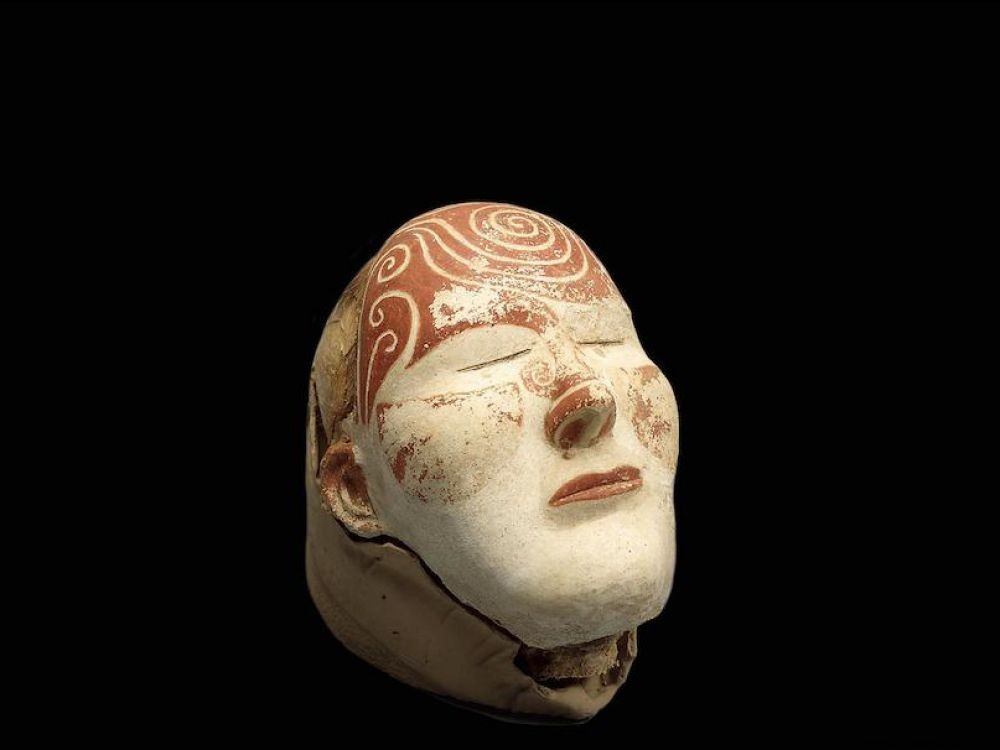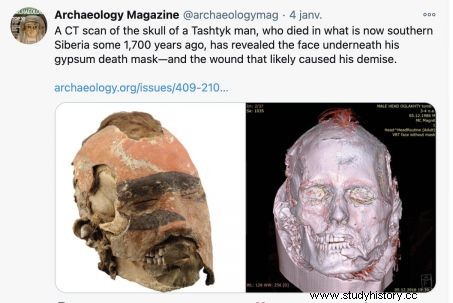Creators of surprisingly realistic death masks, the Tashtyk are one of the most mysterious ancient cultures of the steppe. A look back at little-known funeral customs.

Tashtyk funerary mask (4th century) from the necropolis of Oglakhti, in Siberia.
A recent analysis of the coating of a tashtyk skull from the 3rd century AD, named after this little-known Siberian people, by researchers at the Hermitage Museum in Saint-Petersburg (Russia), has made it possible to glimpse the face of its owner according to a study published in the January/February 2021 issue of the British journal Archaeology magazine. The CT scan revealed that he had a large gash on his left side and that the wound had been stitched up after death…perhaps so that the deceased would not show up disfigured in the afterlife.
In May 2016,Sciences et Avenir had devoted an article to the Tashtyk people, who roamed the steppes of present-day Russia between the 5th century BC. J.C and the fifth of our era. Researchers still know little about this culture. Their existence was discovered in Siberia at the end of the 18th century and the first archaeologist to find traces of them was Alexander Andrianov, in 1883, at the burial site of Oglakhti, near the town of Abakan. This cemetery has yielded beautiful, well-preserved masks, as well as intact fur hats, silk garments, shoes, hairpins, and archery items.
A recent analysis of the coating of a tashtyk skull from the 3rd century AD, named after this little-known Siberian people, by researchers at the Hermitage Museum in Saint-Petersburg (Russia), has made it possible to glimpse the face of its owner according to a study published in the January/February 2021 issue of the British journal Archaeology magazine. The CT scan revealed that he had a large gash on his left side and that the wound had been stitched up after death…perhaps so that the deceased would not show up disfigured in the afterlife.
In May 2016,Sciences et Avenir* had devoted an article to the Tashtyk people, who roamed the steppes of present-day Russia between the 5th century BC. J.C and the fifth of our era. Researchers still know little about this culture. Their existence was discovered in Siberia at the end of the 18th century and the first archaeologist to find traces of them was Alexander Andrianov, in 1883, at the burial site of Oglakhti, near the town of Abakan. This cemetery has yielded beautiful, well-preserved masks, as well as intact fur hats, silk garments, shoes, hairpins, and archery items.
 CT scan of a Tashtyk skull, performed at the Hermitage Museum, St. Petersburg (Russia). Credits:The Siberian Times - Archeology Magazine
CT scan of a Tashtyk skull, performed at the Hermitage Museum, St. Petersburg (Russia). Credits:The Siberian Times - Archeology Magazine
Two main types of burials
The tombs also often contained many statuettes of hybrid animals, sometimes articulated, as well as gold jewelry and iron tools. Several burials have also yielded objects of Chinese influence. The bodies were buried either in individual graves or grouped together in collective vaults. There were the naturally mummified deceased, but also, more surprisingly, sorts of giant funerary dolls:human-sized figurines made of leather, stuffed with dry grass, on whose face masks could be placed. For a long time, archaeologists saw it as a symbolic representation of wives or servants. Until X-rays revealed the presence of small sheepskin bags placed at chest level, which contained the cremated remains of the deceased. These mannequins were actually cremation urns!
The death masks were made of kaolin and gypsum powder (calcium sulphate) mixed with sand. The paste was directly deposited and modeled on the face of the deceased or sometimes even on a square of fabric. She could also wrap the neck and ears. The dead man's brain was first removed by trepanation. Once dried, these effigies were adorned with facial decorations, probably copies of the tattoos that men and women wore on their faces. These strikingly realistic funeral customs are among the most precious assets of Russian heritage, the few best-preserved examples of which are now on display at the Hermitage Museum in Saint-Petersburg.
A people of warriors shrouded in mystery
Of European origin, the Tashtyks would have lived east of the great plains of the Minusinsk basin until the last upheavals of the Western Roman Empire (5th century). This people of warriors would have appeared in a space hitherto occupied by an earlier population, the Tagars. Before mixing a few centuries later with cultures with a majority proto-Mongolian, whose periods of arrival are part of the debates that punctuate the history of Siberian archaeology. They could also be the ancestors of various indigenous peoples of southern Siberia, such as the Shors, Altaians, Teleuts, and Khakases with whom they share common traits, including in funeral rites.
*Sciences et Avenir n°831 May 2016
